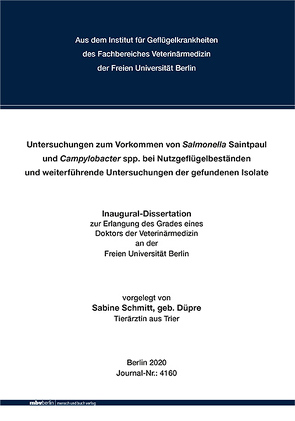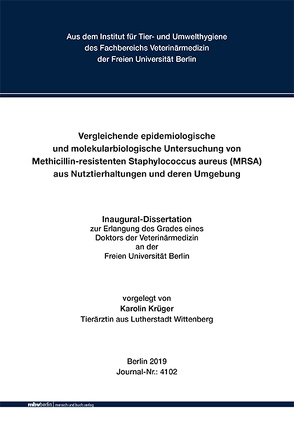
"Investigations on the occurence of Salmonella Saintpaul and Campylobacter spp. in poultry stocks and further investigations of the detected isolates"
The aim of this study was the evaluation of the samples, which were sent to the Institut für Geflügelkrankheiten of the Freie Universität Berlin from 2008 – 2011 because of statutory Salmonella investigation of poultry flocks. Further investigations were done with isolated Salmonella Saintpaul, which are one of the most often isolated serovars in turkeys. In 2013, S. Saintpaul has been the most often isolated serovar in fattening turkeys in the EU.
Also in this study, it was the most often isolated serovar in fattening turkeys from 2008 to 2010. In 2011 it was at 4th place after S. Infantis, S. Coeln and S. Typhimurium. S. Saintpaul can be a human pathogen and is frequently isolated from poultry meat samples, which is why we took a closer look at this serovar.
For further discrimation of the isolates a pulsed-field-gel-electrophoresis (PFGE) protocol was established. A total of 74 S. Saintpaul isolates were examined by PFGE, of which 67 isoaltes originated from fattening turkeys and seven from laying hens. Moreover 62 of the 74 isolates were tested for antimicrobial resistance. The resistance profiles were also used for discrimination. They widely matched with manual and computer analysis of the PFGE patterns.
Isolates matched from 35 – 100%, at which matching was higher the shorter the time between the sampling periods was.. Furthermore, there was a very high matching inbetween isolates from day-old-chicks over a timespan of four weeks, which were isolated from several flocks in Germany. This is most likely linked to the same origin of the chicks from the same breeder herds or via horizontal transmission at the hatchery. Unfortunately, the origin of the chicks in this study was unknown. We also found a very high match of isolates from day-oldchicks and laying hens. This indicates a common source of infection (i.e. wild birds, trucks, flock visitors, feed, etc.), what will not be solved without further investigation.
Another aim of this study was the attempt to isolate Campylobacter spp. from the samples sent to us due to statutory Salmonella investigation of poultry stocks. Till now there is no statutory provision for diagnosis of Campylobacter spp. in poultry stocks so we further investigated the method used in this study by other procedures.
First we performed isolation like in ISO 10727/2006 described, but instead of 10 ml of the Salmonella-preenrichement we only used 1 ml to not disturb the Salmonella diagnostics. We only found a prevalence of 18,1% in fattening turkeys and 9,4% in chickens. In fattening turkeys considerably more C. jejuni than C. coli were isolated, whereas in laying hens, it was more C. coli. This correlates to what was reported in the published literature. The very low prevalence instead contradicts the literature, why the isolation method was further checked.
Therefore we established a qantitative multiplex Realtime-Polymerase chain reaction (Multiplex qPCR). We investigated retained samples of the Salmonella preenrichement for the existence of Campylobacter-DNA. Here in 58,9% of the turkey samples and 96,3% of the laying hen samples Campylobacter-DNA was found. This is correlates to the literature.
It was noticed that the isolation results were worse the warmer the outside temperature had been. So we conducted storage trials to simulate the usual postal transportation of the Salmonella samples. Therefore, in the first trial we stored two different types of boot swabs for 30 Minutes, one day, two days, three days, four days and five days at different temperatures. Those swabs were scaled right after sampling and before testing to determine the weight loss. This weight loss was equalized with fluid loss. The weight loss unsurprisingly was higher the warmer the outside temperatures had been. We took a second standardized trial where we contaminated fecal samples of a negative laying hen flock with Campylobacter colonies and put the same amount of feces we found in trial one on the boot swabs. The swabs were again stored and investigated like in trial one.
The trials showed that the postal transportation is really disadvantageous for the isolation of Campylobacter spp. because of the oxidative stress for the bacteria, especially at high outside temperatures. A cooled transport to the laboratory is mandatory. If the cooling chain can be maintained the transportation can also endure longer than one day without compromising the isolation outcome.
Overall the isolation of Campylobacter spp. from the sent samples is not suitable for routine diagnostics. The Multiplex qPCR could be a reasonable alternative because of the rapidness of the method and the very low detection limit of Campylobacter-DNA. In addition in this study we further discriminated 54 C. jejuni isolates via sequencing of the Short Variable Region of the Flagellin A Gene (flaA-SVR). This showed a host specific as well as geographic relatedness. There was no time related relation.
Aktualisiert: 2022-12-31
> findR *

Comparative epidemiological and molecular biological analysis of methicillin-resistent Staphylococcus aureus (MRSA) from livestock and its environment
Within the scope of this present study, selected samples which were isolated in the course of a partial project between the Free University Berlin and the Veterinary University Hannover from 2009 to 2011, have been further investigated. The objective of that previous study was to comprehensively determine the occurrence of MRSA in barn air and housing environment in animal husbandries of different animal species in Germany. To estimate an appropriate transfer risk of airborne MRSA from livestock to other animal populations or local residents, field studies have been performed in conventional pig and poultry farms.
Within the following thesis the emission of MRSA from barn air to the vicinity of the farms should be proven by using molecular biological analysis. Furthermore, a differentiated evaluation regarding to the tenacity and pathogenicity of transmitted and sedimented MRSA should be performed. Finally, results of macrorestriction analysis were compared to an approach of using protein spectra obtained by MALDI-TOF-MS for molecular epidemiology.
Overall 238 selected MRSA isolates originating from four fattening pig farms and two breeding pig farms as well as two broiler and four turkey fattening farms were further investigated. The spa- typing demonstrated that in pig barns and its environment the spa-types t011, t108 and t1451 were identified most frequently, whereas t011, t5452 and t034 dominated in the inside and outside of the turkey farms respectively t1430 in the broiler farms. The majority of the selected isolates (87%) were assigned to clonal complex 398. All so-called non-CC398 strains (13%) were assigned to sequence type ST9 or ST5. A simultaneous detection of the same MRSA spa types inside the barns and within the whole farm confirmed the hypothesis of the previous study that an emission via the airborne route has been occured.
The clonal analysis was performed by Cfr9I pulsed-field gel electrophoresis. Therefore 124 MRSA isolates (60 from pig farms, 34 from broiler farms and 30 from turkey farms) were chosen. The results demonstrated the presence of MRSA clones in the barn air and housing environment of investigated animal husbandrys. In addition, MRSA clones could also be detected in air samples from inside as well as from outside on the downwind site up to a distance to 50m and 150m, respectively. Because air sampling was performed simultaneously we can assume a proven airborne transmission of MRSA from livestock.
In order to compare transmitted and sedimented MRSA under changing environmental conditions, pig isolates from summer and winter samplings were investigated. As a result, MRSA clones were detected in samples from winter and the following summer at identical distances. This confirms the hypothesis of the previous study that sedimented MRSA strains show high tenacity in the environment by surviving longer periods on soil surfaces.
Additionally, a series of 38 samples were selected for microarray analysis. Investigated MRSA strains displayed only a low presence of virulence associated genes. Resistance genes for beta-lactam antimicrobials were detected in all isolates. Genes mediating resistance to other antimicrobial classes were also frequently detected. Furthermore, the Panton-Valentine Leukozidin gene and the Toxic Shock Syndrome Toxin gene could not be identified in any of the positive MRSA strains. While all investigated MRSA strains might be able to form bacterial biofilms, genes for staphylococcal entertoxins were found in only 31,6 % of the investigated isolates. However, the detection of antibiotic resistance genes or genes encoding for SE does not mean that appropriate genes will be expresses and own a pathogenic potential for humans and animals
Finally protein mass spectra obtained by MALDI-TOF-MS and macrorestriction analysis were compared with each other in regard of their usability for molecular epidemiology. Phylogenetics on the basis of PFGE analysis is widely accepted. Cluster analysis of protein spectra differed substantially from the widly PFGE ones. For this reason using MALDI-TOF-MS for typing MRSA for epidemiology purpose is not recommended yet. However, further investigations on this topic seem to be necessary and useful.
Aktualisiert: 2019-12-31
> findR *
MEHR ANZEIGEN
Bücher zum Thema Pulsfeld-Gelelektrophorese
Sie suchen ein Buch über Pulsfeld-Gelelektrophorese? Bei Buch findr finden Sie eine große Auswahl Bücher zum
Thema Pulsfeld-Gelelektrophorese. Entdecken Sie neue Bücher oder Klassiker für Sie selbst oder zum Verschenken. Buch findr
hat zahlreiche Bücher zum Thema Pulsfeld-Gelelektrophorese im Sortiment. Nehmen Sie sich Zeit zum Stöbern und finden Sie das
passende Buch für Ihr Lesevergnügen. Stöbern Sie durch unser Angebot und finden Sie aus unserer großen Auswahl das
Buch, das Ihnen zusagt. Bei Buch findr finden Sie Romane, Ratgeber, wissenschaftliche und populärwissenschaftliche
Bücher uvm. Bestellen Sie Ihr Buch zum Thema Pulsfeld-Gelelektrophorese einfach online und lassen Sie es sich bequem nach
Hause schicken. Wir wünschen Ihnen schöne und entspannte Lesemomente mit Ihrem Buch.
Pulsfeld-Gelelektrophorese - Große Auswahl Bücher bei Buch findr
Bei uns finden Sie Bücher beliebter Autoren, Neuerscheinungen, Bestseller genauso wie alte Schätze. Bücher zum
Thema Pulsfeld-Gelelektrophorese, die Ihre Fantasie anregen und Bücher, die Sie weiterbilden und Ihnen wissenschaftliche
Fakten vermitteln. Ganz nach Ihrem Geschmack ist das passende Buch für Sie dabei. Finden Sie eine große Auswahl
Bücher verschiedenster Genres, Verlage, Autoren bei Buchfindr:
Sie haben viele Möglichkeiten bei Buch findr die passenden Bücher für Ihr Lesevergnügen zu entdecken. Nutzen Sie
unsere Suchfunktionen, um zu stöbern und für Sie interessante Bücher in den unterschiedlichen Genres und Kategorien
zu finden. Unter Pulsfeld-Gelelektrophorese und weitere Themen und Kategorien finden Sie schnell und einfach eine Auflistung
thematisch passender Bücher. Probieren Sie es aus, legen Sie jetzt los! Ihrem Lesevergnügen steht nichts im Wege.
Nutzen Sie die Vorteile Ihre Bücher online zu kaufen und bekommen Sie die bestellten Bücher schnell und bequem
zugestellt. Nehmen Sie sich die Zeit, online die Bücher Ihrer Wahl anzulesen, Buchempfehlungen und Rezensionen zu
studieren, Informationen zu Autoren zu lesen. Viel Spaß beim Lesen wünscht Ihnen das Team von Buchfindr.

